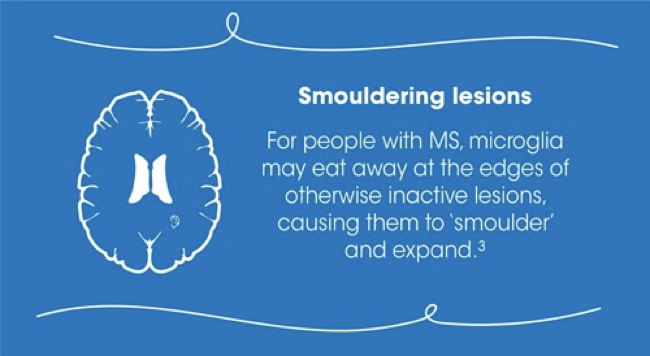The Science of MS
What is smouldering MS?

Have you heard about ‘smouldering MS’? Don’t worry if not, as it’s a relatively recent term used to describe a specific process that happens in people living with MS. Unfortunately, much of the information available about this topic isn’t easily accessible to patients as it’s often written as part of a scientific publication or on a website better suited to healthcare professionals. But this is where we can help!
We’ve created this article to help you understand smouldering MS and how its lesions differ from the lesions most commonly associated with MS. We will briefly explore the impact that smouldering lesions can have on MS disease progression, and also cover some simple steps that you can take that may help to reduce the effect that smouldering MS has on your life.
Smouldering MS is characterised by the presence of smouldering lesions, a specific type of lesion observed in people living with MS that is chronically active and grows slowly over many years. You may also see them referred to as ‘rim lesions’, ‘chronic active lesions’ or ‘slowly expanding lesions’, alternative names used by scientists studying this particular area of MS disease.

Smouldering lesions are common in people living with MS and can affect anyone, regardless of the type of MS someone has or whether someone has a history of taking a disease modifying therapy (DMT). However, they are generally associated with progressive, and more aggressive and damaging forms of MS
Smouldering lesions differ from the normal lesions associated with MS, both in terms of appearance and behaviour.
Non-smouldering lesions have the ability to shrink or even to completely heal and disappear over time. This is in stark contrast to the behaviour of smouldering lesions which are thought to represent long-term, active inflammation in MS that is continuous in nature. These lesions instead remain and actively expand for many years.
A team of researchers have recently developed an imaging technique which makes it possible to visualise smouldering lesions and distinguish them from lesions that don’t smoulder based on their appearance – something that wasn’t previously possible. Using this advanced imaging technology, a distinctive, dark rim can be observed around smouldering lesions.
This rim is a visual characteristic that differentiates these lesions from others and is caused by microglia, a type of immune cell that roams the central nervous system (CNS) to remove any cell fragments, waste, and foreign material, such as bacteria and viruses. This is also why smouldering lesions are sometimes called ‘rim lesions’. Microglial activity in the CNS is normal and healthy, but that microglia can sometimes be triggered into an overactive state and that this is when they can cause disease.
We must clarify that smouldering lesions is still a relatively new topic and the role they play in MS is not fully understood, with further research required for us to realise the exact significance of this particular type of MS activity for people living with the condition.
However, a recent study of 192 people living with MS found that those with smouldering lesions were more likely to develop cognitive and mobility problems at an earlier age and had a lower brain volume when compared to people without any smouldering lesions. The study also concluded that people presenting with smouldering lesions were more likely to have MS that had become progressive.

While much more research is needed to understand the role of smouldering lesions in the progression of MS, and who with MS is at the greatest risk, these key findings suggest that smouldering lesions may be associated with more severe forms of the condition.
Smouldering MS activity should not be overlooked, particularly given that initial research has linked the presence of smouldering lesions to worsening MS symptoms and disease progression.
Here are two key steps that you can take that may help to reduce the impact of smouldering lesions on your life:

Attend your appointments
It’s incredibly important that you continue to attend your regularly scheduled MRI appointments with your neurologist, even if you aren’t exhibiting any clear MS symptoms at the time. This way, any smouldering lesions may be detected and acted upon.
Stick to your management plan
Although there’s limited research, there’s some evidence to suggest that smouldering lesions may respond to treatment with certain DMTs – this is why it’s crucial that you continue to adhere to your MS management plan, as there’s the potential it could help with any underlying smouldering MS you’re unaware of
If you’re concerned about the progression of your MS or the potential impact that smouldering lesions might have on your future, tell your doctor how you feel. You can even create your own Talk To Your Doctor Guide to help you navigate these conversations with your healthcare team.
- MS Trust – MRI reveals smouldering MS lesions. Available at: https://mstrust.org.uk/research/research-updates/191030-smouldering-lesions. Accessed August 2021.
- The MS Blog – Smouldering MS – Not All Bad News. Available at: https://multiple-sclerosis-research.org/2021/07/smouldering-ms-not-all-bad-news/. Accessed August 2021.
- Multiple Sclerosis News Today – Need to Know: MS and Smoldering Lesions. Available at: https://multiplesclerosisnewstoday.com/news-posts/2019/11/12/need-to-know-about-smoldering-lesions/. Accessed August 2021.
- MS-UK – “Smouldering spots” in the brain may signal severe MS. Available at: https://www.ms-uk.org/%E2%80%9Csmouldering-spots%E2%80%9D-brain-may-signal-severe-ms. Accessed August 2021.
- MultipleSclerosis.net – What Are Smoldering Lesions? Available at: https://multiplesclerosis.net/clinical/smoldering-lesions. Accessed August 2021.
Related Items

Treating MS Early
Learn about why it is so important to start treatment as soon as possible after your MS diagnosis.

Talk to Your Doctor Guide
Create a personalised guide to help you evaluate and discuss your MS at appointments with your neurologist.

Monitoring the brain in MS
Learn about how MS activity is monitored, specifically how MRI scanners are used to see what is going on in your brain.